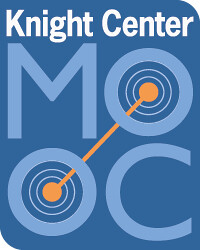

The Knight Center for Journalism in the Americas’ first MOOC (massive open online course) started on Sunday, Oct. 28, reaching more than 2,000 people from 109 countries. The demand for the course was so high that registration for the massive class had to be limited due to concerns about server capacity. More than 1,000 people are already registered, lining up for a second edition of the same course that will start in January.
The six week course Introduction to Infographics and Data Visualization is taught by Alberto Cairo, an internationally renowned expert in the field. He is currently teaching at the University of Miami’s School of Communication and has taught several regular online courses at the Knight Center’s distance learning platform. Chapters of Cairo’s new book, The Functional Art are used in the course. He also uses his Twitter account @AlbertoCairo to complement class discussions.
As opposed to the most common MOOCs, which are just videos of regular college classes and reading materials, the Knight Center’s pioneering MOOC has been built especially for this new, massive format. Cairo has developed an original syllabus to fit such a large class and has already started to manage fascinating discussions with hundreds students from around the world.

“Perhaps it’s too early to say, but I believe that the whole experience is being great, both for me and the participants,” Cairo said. “Contrary to what happens in other MOOCs, I actively participate in discussions, answer questions, and even provide feedback on the infographics projects they will make in weeks to come. I won’t be able to do that for every single project, obviously (after all, we have 2,000 people!), but I will be able to select 15 or 20 each time and will write generic feedback based on them.”
“We are navigating uncharted waters with this project. It is very exciting and I am grateful to Alberto Cairo and to the Knight Center’s e-learning team who has worked hard on this groundbreaking project,” said professor Rosental C. Alves, founder and director of the Knight Center for Journalism in the Americas at the University of Texas at Austin. “We are using our nine-year experience of teaching journalism online to smaller groups, and adapting our multimedia platform to reach bigger crowds of students, as we believe that there is a growing need for journalism training for journalists and non-journalists alike.”
“This course was originally planned as an introduction to infographics and visualization for journalists and news designers. And we certainly have those participating. But many, many others, come from other fields: medicine, social sciences, business administration,” said Alberto Cairo. “Today, second day of the course, I answered a question from an epidemiologist, who praised the fact that one of my favorite historical graphics, John Snow’s famous 1854 cholera map is related to her field. The kind of interaction you can get having people with such different backgrounds is enlightening”.
The current MOOC that started on Sunday will end on December 8. The Knight Center will open soon registration to a second edition of Alberto Cairo’s MOOC Introduction to Infographics and Data Visualization. The new course will start on January 12, 2013 and end on February 23. Priority to this course will be given to more than 1,000 people who have registered as users in the Knight Center MOOC’s website but were not able to take the first edition of Alberto Cairo’s course.
In just a few days the course’s registration limit of 2,000 students was reached for the first MOOC, attracting people from 109 countries. The United States is the country with the most students registered for the MOOC with 687 participants, followed by Spain (203), Brazil (132), United Kingdom (121), Mexico (68), Canada (60), India (52), Australia (43), Portugal (42), Netherlands (39), Germany, the Russian Federation (with 36 each), Italy (29), Ukraine (26), South Africa, Colombia (with 23 each), Argentina (25) and Chile (20).
Other countries with more than one student were the United Arab Emirates, Austria, Bangladesh, Belgium, Bolivia, Switzerland, China, Costa Rica, Cuba, Cyprus, Czech Republic, Denmark, Dominic Republic, Ecuador, Estonia, Egypt, Finland, France, Ghana, Greece, Guatemala, Hong Kong, Croatia, Hungary, Indonesia, Ireland, Jamaica, Japan, Kenya, Cambodia, Lebanon, Sri Lanka, Lithuania, Luxemburg, Republic of Moldova, Nigeria, Norway, Nepal, New Zealand, Peru, Philippines, Poland, Puerto Rico, Paraguay, Qatar, Romania, Sweden, Singapore, Slovenia, Slovakia, Thailand, Uganda, Uruguay, Venezuela, Zambia and Zimbabwe.
Some countries had just one student each, like Andorra, Afghanistan, Azerbaijan, Bosnia and Herzegovina, Bulgaria, Burundi, Belarus, The Democratic Republic of the Congo, Cameroon, Algeria, Ethiopia, Federated States of Micronesia, Georgia, Honduras, Israel, Iraq , Islamic Republic of Iran, Iceland, Kazakhstan, Latvia, Morocco, Malaysia, Oman, Panama, Pakistan, Serbia, Rwanda, Senegal, Suriname, Syrian Arab Republic, Tunisia, United Republic of Tanzania, and Wallis and Futuna.
The Knight Center for Journalism in the Americas was created in 2002 by Professor Rosental Alves at the University of Texas at Austin School of Journalism thanks to a generous donation from the John S. and James L. Knight Foundation, which has been supporting it continually. The Center also receives major contributions from the Open Society Foundations and The University of Texas at Austin. The Center’s main goal is to help journalists in Latin American and the Caribbean to improve the quality of journalism in their countries.